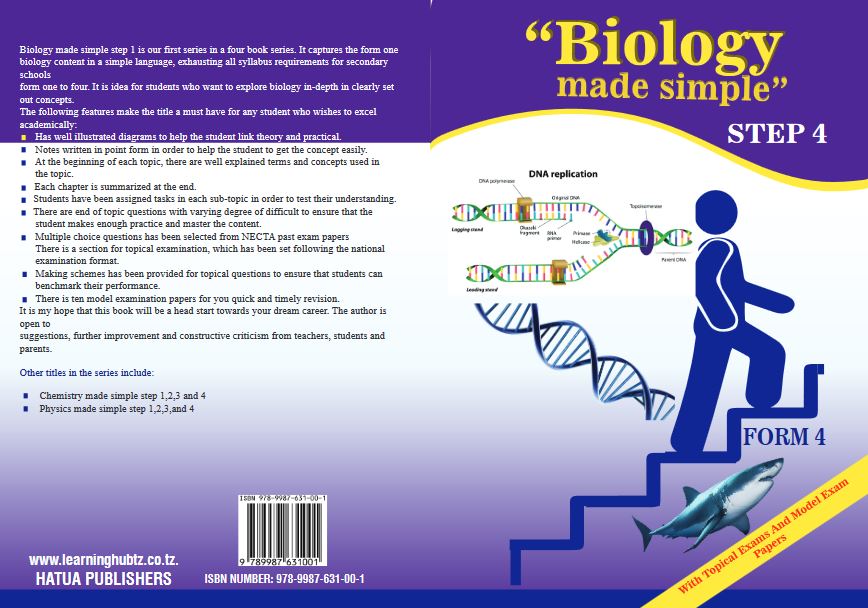CHAPTER 1
INTRODUCTION TO BIOLOGY.
KEY TERMS AND CONCEPTS.
-
Biology - This is a scientific study of living things.
-
Cell - this is a basic unit of life.
-
Magnification- this is a technique by a small organism is made to appear large.
-
Sensitivity - this is a process by which a living organism sense changes in environment
-
Stimuli - this is a change in the environment
-
Respiration - this is the process by which living organisms breakdown food in their bodies to release energy.
-
Reproduction- this is the process by which living organisms give rise to new offspring.
-
Cytology - this is the study of cells
-
Anatomy - this is the study of physical structures of organism
-
Ecology - this is the study of relationship between organisms and the environment
-
Entomology- This is is the scientific study of insects
-
Taxonomy - this is the study of classification
-
Parasitology - this is the study of parasites
-
Mycology - this is the study of fungi
-
Genetics - this is the study of inheritance and variation.
-
Botany - this is the study of plants
-
Zoology - this is the study of animals
-
Afforestation - this is the practice of planting of trees
-
Reafforestation - this is replacing of trees where they have been cut.
The word Biology comes from two Greek words: bios and logos. Bios means life and logos means `study. Therefore, Biology is the study of life. The people who study Biology are called biologists.
To study life, biologists focus on the features that are common to all living things. Living things are also called organisms. They include plants, animals and microorganisms which are very small living things such as bacteria and viruses.
Life is the state of living which plants, animals and other living organisms have before they die, and which objects (non-living things) do not have. The basic unit of life is a cell. All living things are made up of cells. Cells are so small that they cannot be seen with a naked eye but with the help of a microscope.
A microscope is used to view cells. A microscope is an instrument that is used in scientific study to make very small things look bigger so that they can be examined easily. This is called magnification. There are two types of microscopes, light microscope and electron microscope.
The simplest living things consist of one cell. These are called unicellular organisms. They include
-
bacteria such as vibrio cholerae,
-
viruses such as HIV
-
protozoa such as amoeba.
-
yeast
Larger, more complex organisms, for example human beings, fish and trees are made up of millions or even billions of cells. They are referred to as multicellular organisms.
Characteristics of living things
Living things have seven characteristics that make them different from non-living things. These characteristics include:
-
reproduction
-
nutrition
-
movement and locomotion
-
response and irritability
-
gaseous exchange and respiration
-
growth and development
-
Excretion.
Nutrition
This is the process by which living organisms feed on materials from the environment. Green plants, blue-green bacteria and some protoctists make their own food. They use raw materials such as carbon dioxide water and sunlight. There are two forms of nutrition; autotrophic and heterotrophic nutrition.
Respiration
The food taken in by organisms contains energy. However, this energy is not in a directly usable form. The food has to be broken down into small. Particles in order for it to release energy.
Respiration is the process by which food substances are broken down to produce useful energy in a cell. There are two types of respiration, aerobic respiration and anaerobic respiration .
Excretion
Processes such as nutrition and respiration produce useful substances and by-products. Some of the byproducts can be harmful if left to accumulate in the organism. Excretion is the process by which these by-products are removed from the organism. The by-products are also called excretory products. Examples of excretory products are urea, excess water, carbon dioxide and water vapor.
Urea and excess water are removed in the form of urine and small amounts are removed as sweat through the skin.
Water vapor and carbon dioxide are removed during exhalation or breathing out.
Growth and development
Growth is permanent increase in size and mass of an organism. All living organisms can grow.
During growth, the size of an organism increases permanently. Growth is caused by an increase in the number of cells that make up an organism.
Development occurs when cells become specialized to perform specific functions. This causes an organism to change in shape and form, and also to become more complex. Cell division through mitosis, cell elongation cell specialization and cell differentiation all contributes to growth and development.
Sensitivity or irritability
The ability of an organism to detect and respond to a change in its environment is called sensitivity or irritability Living things detect and respond to changes in their environment . The changes that organisms detect and respond to are called stimuli (singular: stimulus). For example, human beings can feel and react to heat, cold or pain. A snail hides its body inside its shell when touched. Heat, touch and pain are examples of stimuli.
Plants also respond to stimuli. However, the responses may not be very fast or visible. The Mimosa is an example of a plant that clearly shows sensitivity. When this plant is touched, it curls its leaves.
Movement
-
This is the act of changing position. Movement occurs in cellular level and in organism level.
-
All organisms can move on their own accord in response to their environment. Non-living things only move when pushed or pulled by someone or something.
-
Some living things move from place to place in search of food, water, shelter, mates or suitable temperatures. Movement involving the whole body of an organism is called locomotion . For example, animals can walk, run or crawl.
Plants show movement in terms of growth of their body parts, for instance movement of plant roots towards water and shoots towards light.
The following are the importance of movement;
-
enables organisms to search for mates
-
movement enables organisms to escape from danger
-
Organisms are able to move to suitable stimuli.
-
Enables organisms to search for food
Reproduction
This is one of the most important characteristics of living things. Living things produce new individuals of their own kind. For example, human beings give birth to human beings, chicks hatch from eggs and maize seeds grow into maize plants, cows delivers calves. Reproduction ensures the continuity of organisms. There are two types of reproduction; these are sexual reproduction and asexual reproduction .
Sexual reproduction occurs when there is fusion of male and female gametes and involves two parents. Asexual reproduction does not involve fusion of male and female gametes, and involves one parent.
Branches of Biology
There are two main branches of Biology, namely botany and zoology . Botany is the study of plants
and zoology is the study of animals. However, there are many minor branches of Biology that deal with different aspects of living things.
The following are some of other branches of biology.
-
Anatomy - this is the scientific study of internal structures of organism
-
Physiology -this is the study of body functions
-
Cytology - this is the study of structure and functions of cells
-
Ecology - the relationship between organisms and their environment
-
Entomology -this is the study of insects
-
Genetics - this is the study of hereditary and variations
-
Immunology- the study of body defense mechanisms against micro-organisms
-
Microbiology - this is the study of small organisms
-
Mycology - this is the study of fungi
-
Parasitology - this is the scientific study of parasites
-
Taxonomy - scientific study of classification
-
Bacteriology - this is the scientific study of bacteria
-
Viroloy - study of viruses
|
|
|
|
|
|
|
|
|
|
|
|
|
|
|
|
|
The importance of studying Biology.
The knowledge we get from studying Biology is valuable for many reasons. These reasons include the following:
-
Biological studies identify and group living things. It therefore becomes easier to learn more about organisms.
-
Biology helps us to understand our environment better and how to take care of it. We learn about the plants, animals and microorganisms that surround us and how they affect us. That way, we can take care of our surroundings properly.
-
Biology helps us to appreciate nature. We learn many fascinating things about different organisms and how they function.
-
While studying Biology we acquire research skills that are useful when carrying out scientific investigations. Such skills include measuring, observing, step-by-step analysis and making correct conclusions. Thus one can become a researcher.
-
Scientists continue to develop higher-yielding and disease-resistant varieties of plants and animals. These new breeds of plants and animals are called hybrids. They help us to improve food production.
-
The knowledge acquired in Biology has enabled scientists to come up with ways to prevent, treat and cure diseases. This has greatly improved peoples lives.
-
Biology is important because it helps us enter in careers such as teaching, nursing, medicine, horticulture and environmental science.
-
Biological research encourages international cooperation. For instance, biologists from all over the world work together to find cures for killer diseases such as swine flu, AIDS and bird flu.
The relationship between biology and other scientific fields.
Biology is related to many other fields of study such as agriculture, medicine, pharmacy, veterinary medicine and nutrition. These areas involve research on living things. Biological findings have a direct impact on the development of these fields as explained below.
Agriculture
-
Agriculture is the practice of growing crops and rearing animals for food and for sale.
-
Biological research findings on crops and livestock have led to improved agricultural production.
-
For example, scientists have developed breeds of crops and animals that mature quickly and produce high yields.
-
For instance, traditional breeds of chicken start to lay eggs when they are about eight months old compared to the modern breeds known as layers which start to lay eggs from as early as five months.
Researchers have also developed breeds of crops and animals that do well under specific climatic conditions.
-
For example, researchers have come up with varieties of maize seeds that grow well even in harsh conditions and are more resistant to diseases.
Medicine and pharmacy
-
Medicine is the study of the prevention, treatment and cure of diseases.
-
Pharmacy deals with the preparation and administration of medicines .
-
Anatomy and immunology form an important part of the study of medicine.
-
The study of anatomy helps doctors to learn the structure of the body and how it functions. This makes it possible for a doctor to know when something is wrong in the body and how it can be treated.
-
In immunology , scientists study the bodys response to disease-causing organisms .
-
This knowledge is important in the formulation of vaccines and drugs that are able to fight and cure diseases, respectively.
-
Some of these drugs and vaccines are made from animal or plant materials or from microorganisms. For example, insulin which is used to treat diabetes can be obtained from cows or pigs.
-
Scientists are also developing insulin from bacteria to replace one from animals
-
Veterinary medicine involves the treatment of animals that are ill or injured.
-
Biologists study the structure of animals and the effects of microorganisms on animals. This helps them to understand animal diseases and injuries and therefore come up with suitable treatment methods.
Nutrition
Nutrition means the study of composition, functions and sources of various types of food.
-
The study of Biology is important in understanding the composition and value of different types of foods.
-
This knowledge is used by dieticians to determine the kind of diets suitable for people with different health problems.
-
Biologists have also developed breeds of livestock and crops that give products of higher nutritional value.
-
Examples include Jersey cattle which produce milk with very high butter content, and sweet potatoes that contain vitamin A. Such breeds are known as hybrids .
-
A person who studies nutrition is called a nutritionist. These people help prescribe the right type of food to individuals with certain conditions.
Forestry
-
Forests are sources of fuel, building materials and medicinal plants. They are also water catchment areas.
-
Biologists have developed varieties of trees that grow well in dry areas. Such trees are used to reclaim dry land for human settlement.
-
This is called afforestation. Biological research has come up with varieties of trees that mature fast. The fast growing trees are planted to replace those that have been cut down. This is called reafforestation .
-
Reforestation helps to preserve water catchment areas so that we have a continuous supply of water.
-
Forests also prevent desertification. The knowledge of biology helps people to understand growth requirement of various trees and well to take care of them.
The relationship between biology and other subjects
Geography
-
Geography is concerned with the study of the Earth and its elements to explain its origin, structure and evolution.
-
Data such as these allow us to know the conditions under which different biological processes occur and whether or not they influence the development of such processes.
-
Geography can also be useful for a biologist to determine the distribution of species of living organisms in different latitudes of the world, and how that location can affect their characteristics and functions.
Physics
-
Through physics, we are able to know the biological systems at molecular or atomic level.
-
Physics has also led to the invention of microscope which is a very important tool studying biology.
-
Biology applies natural physical laws, since everything is composed of atoms.
-
For example, physics allows explaining how bats use sound waves to move in the dark, or how the movement of the limbs of different animals works.
Chemistry
-
Chemistry is important as it is very useful to identify and understand the reactions that occur between the different substances that make up and intervene in the different processes that the organism experiences.
-
Its relevance is more clearly recognized in the description of metabolic processes such as respiration, photosynthesis and digestion.
Mathematics
-
Biology requires this science to process, analyze and report experimental research data and to represent relationships between some biological phenomena.
-
For example, to determine the prevalence of one species over another in a given space, mathematical rules are useful.
Engineering
-
For an engineer, knowledge about brain functioning is useful for designing algorithms, for example; While for a biologist, advances in medical engineering, for example, are very useful.
TOPIC SUMMARY.
-
Biology comes from two words, bios and logos
-
Bios means life while logos means study
-
Biology is the study of life and living things
-
A person who studies biology is called a biologist
-
There are two main branches of biology, botany and zoology
-
Botany is the study of plants while zoology is the study of animals
-
A living thing is characterized by certain features called characteristics of living things.
-
The basic unit of life is the cell
-
The seven characteristics of living things are reproduction, growth and development, excretion, response and irritability, respiration, movement and locomotion, and nutrition.
-
The study of biology is very important for individual and for the society
-
Biology is related to other fields such as medicine, forestry, vertinary medicine, nutrition among other.
-
There are several other branches of biology such as anatomy, physiology, microbiology etc.
END OF TOPIC QUESTIONS.
-
Choose the correct answer among the given alternatives
-
The following are branches of biology. Which one is not
- Microbiology
-
Ecology
-
Science
-
Taxonomy
-
Biology is a branch of science which is derived from ........ language
- Latin
-
English
-
Greek
-
Swahili
-
A person who study plants is known as a
- A biologist
-
Botanist
-
Scientist
-
Microbiologist
-
The following are characteristics of living things except
- Movement
-
Growth
-
Vomiting
-
Respiration
-
Biology help man to know diseases, their causes, transmission symptoms, and cure/treatment
- Medicine
-
Prevention
-
Immunization
-
Isolation
vi. is a condition at which different cells organize and perform a specific function;
- Cell specialization
- Prokaryotic cell
- Guard cell
- Palisade cell
-
are organisms which have characteristic of living things and non living things;
- Fungi
- Viruses
- Bacteria
- Euglena
-
Bacteria is an example of an organism whose nucleus is;
- Eukaryotic cell
- Prokaryotic cell
- Multi-cellular organism
- Specialized cell
-
Which of the following provides an organism with energy?
- Regulation
- Reproduction
- Respiration
- Synthesis
-
A biologist discovered new cell in the culture, a new cell had a distinct cell wall but did not have a definite nucleus. The cell is mostly like to be;
- Protozoa
- Plant
- Bacterium
- Virus
PART II.
-
Define the following terms;
-
Biology
-
Zoology
-
Botany
-
Virology
-
I) what is the functional unit of life?
ii) Mention two branches of biology
iii) Mention the branch of biology that deals with the following?
-
Cells
-
Fungi
-
Organs
-
Small organisms
-
Viruses
-
A) Mention the seven characteristics of living things
b) Give five reasons why it is important to study biology
c) Mention what is studied in the following;
- Genetics
-Immunology
-Forestry
-
Explain how the following fields are related to biology;
-
Medicine
-
Forestry
-
Nutrition
-
Agriculture
TOPICAL EXAMINATION
INTRODUCTION TO BIOLOGY
INSTRUCTIONS:
Answer all questions
PART A :
Choose the correct answer in the following questions and write it beside each question { 20marks }
1. What does science deals with?
- Study of environment
-
Study of medicine and car manufacturing
-
Study of microscope
-
Study of nature by experiment and observation
-
The following is the list of subjects that are studied under science
- Geography, physics and history
-
Mathematics, economy and book keeping
-
Physics, chemistry and biology
-
History, civics and English
-
Commerce, agriculture and language
iii. Biology is the subject that deals with......
- Study of cells
-
Study of life
-
Study of anatomy
-
Study of animals
iv. The organ that is used for hearing is called..........
- The ear
-
The eye
-
The nose
-
The skin
v. Walking process is done by
- Head
-
Fingers
-
Arms
-
Legs
vi. The fish like tilapia breathe through�
- Lungs
-
Spiracles
-
Gills
-
Skin
vii. Deficiency of iodine in the body can lead to disease called
- Rickets
-
Goiter
-
Night blindness
-
Diabetes
viii. One of the following is not the laboratory rules
- Observing good table manner during eating
-
Do not enter in the laboratory without permission
-
Report any accident to the teacher or lab. Technician
-
Do not eat, drink or taste anything in the laboratory
ix. Waste can be defined as�
- Wanted materials
-
Pleased materials
-
Overused materials
-
Unwanted materials
x. One of the following is not the living things characteristics
- Movement
-
Growth
-
Digestion
-
Respiration
-
MATCHING ITEMS QUESTIONS.
| LIST A | LIST B |
|
|
-
Fill the spaces provided;
-
Skills in studying biology include ...............,...................and.......................................
-
A scientist can be able to reject or accept hypothesis by doing...............................
-
To preserve animals like snakes, and fish in the laboratory of biology we use .......................................
-
The study of mushroom, toad stool, and mucor ...........................................................
-
The person who studies botany.....................................................................................
-
The study of insects is called .......................................................................................
-
The study of how the body of humans functions .........................................................
-
Another name for veterinary is ....................................................................................
-
Gaseous exchange take place between organisms and ................................................
-
The giving rise to new individual of the same kind is .................................................
-
Fill in the blanks:
-
Who is a biologist? ................................................................................................................................................................................................................................................................................................................................
-
Movement done by most animals is known as .......................................................................Plants also have their movement where by plants roots and shoots move towards water, gravity and light this movement is known as ........................................................................................................................
-
Give the meaning of biology ............................................................................................................................................................................
-
Movement is important since it help organism to obtain food, .......................................................................................................................................................
3. State six scientific methods you know.
4. Write down five fields related to biology
-
...............................................................................................................................
-
..............................................................................................................................
-
..............................................................................................................................
-
..................................................................................................................................
-
............................................................................................................................ ..
5. Define the word biology
.........................................................................................................................................................................
6. Write down 3 importance of studying biology
i..........................................................................................................................................
ii........................................................................................................................................
iii........................................................................................................................................
7. List down 4 branches of biology
i.............................................................................................................................................
ii...........................................................................................................................................
iii...........................................................................................................................................
iv...........................................................................................................................................
8. Give five branches of biology
-
_____________________________________________________
-
______________________________________________________
-
______________________________________________________
-
______________________________________________________
-
______________________________________________________
9. Mention characteristics of living things (7)
-
_____________________________________________________
-
______________________________________________________
-
______________________________________________________
-
______________________________________________________
-
______________________________________________________
-
______________________________________________________
-
______________________________________________________
NECTA QUESTIONS INTRODUCTION OF BIOLOGY
1. Mr mabala picked up a telephone after hearing it ringing which characteristic of living things was Mr Mabala showing by these action
- Growth and respiration
-
Irritability and movement
-
Irritability and respiration
-
Locomotion and movement (2012)
-
In biology experiment are used to test
- Facts
-
Hypothesis
-
Laws
-
Problems (2013)
-
Zoology is defined as the study of
- Animals
-
Fungi
-
Plant
-
Cell (2016)
ESSAY QUESTIONS.
-
Discuss the importance of biology in our daily life.
-
Discuss characteristic of living things.
-
Explain the relationship that exists between biology and other disciples.
Hub App
 For Call,Sms&WhatsApp: 255769929722 / 255754805256
For Call,Sms&WhatsApp: 255769929722 / 255754805256
 For Call,Sms&WhatsApp: 255769929722 / 255754805256
For Call,Sms&WhatsApp: 255769929722 / 255754805256
WHATSAPP US NOW FOR ANY QUERY
App Ya Learning Hub Tanzania






